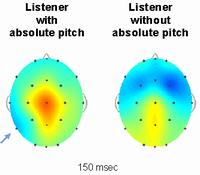Facility
EEG
Electroencephalogram (EEG) has the greatest temporal resolution among various non-invasive techniques for studying human brain functions. EEG reflects the sum of activities of a large number of neurons interacting dynamically in network.
Sensory, motor, or cognitive events modulates the on-going EEG, the small amplitude change of which can be observed as evoked potential (EP) or event-related potential (ERP) by the method of time-locked averaging. We use this technique to investigate the neural substrates of higher brain functions such as music and language (Refs 1–4).
Fig 1.
Possessors and non-possessors of absolute pitch (AP) were presented with pure tones. In listeners with AP, passive listening to the stimuli elicited a unique negativity over left posterior temporal scalp (AP negativity, arrow), at a relatively short latency of 150 msec (Ref. 1). The result suggests a close functional relationship between AP and language.

References
- 1. Itoh, K., Suwazono, S., Nakada, T. Central auditory processing of noncontextual consonance in music: an evoked potential study. Journal of the Acoustical Society of America 128(6), 3781-3787, 2010.
- 2. Itoh, K., Suwazono, S., Arao, H., Miyazaki, K., Nakada, T. Electrophysiological correlates of absolute pitch and relative pitch. Cerebral Cortex 15(6), 760–769, 2005.
- 3. Huang, K., Itoh, K., Suwazono, S., Nakada, T. Electrophysiological correlates of grapheme-phoneme conversion. Neuroscience Letters 366(3), 254–258, 2004.
- 4. Itoh, K., Suwazono, S., Nakada, T. Cortical processing of musical consonance: an evoked potential study. Neuroreport 14(18), 2303–2306, 2003.

